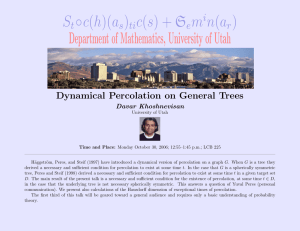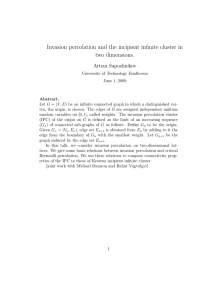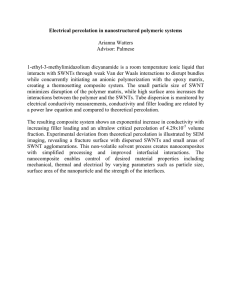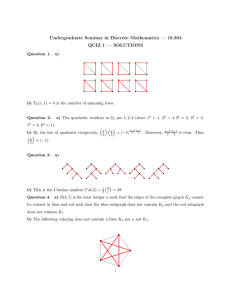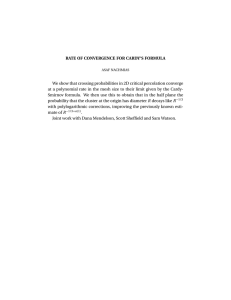Scale-free percolation Joint work with: B Mia Deijfen (Stockholm)
advertisement
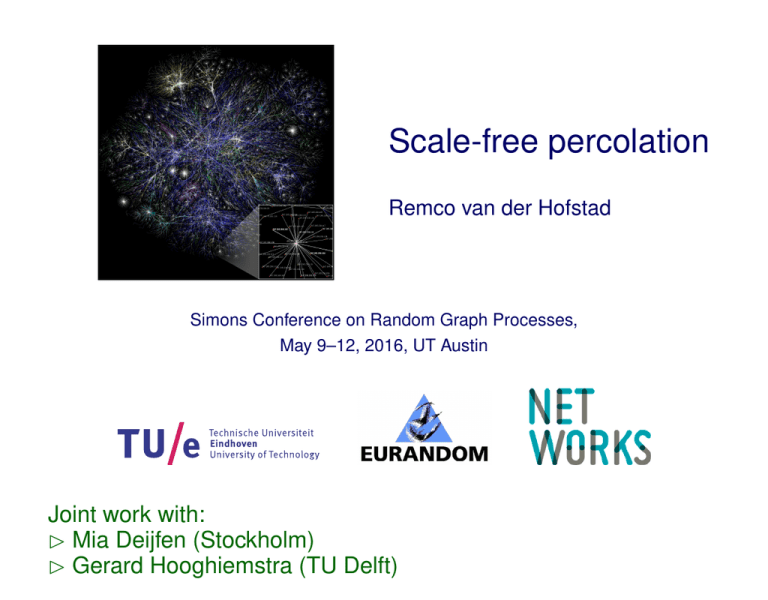
Scale-free percolation
Remco van der Hofstad
Simons Conference on Random Graph Processes,
May 9–12, 2016, UT Austin
Joint work with:
B Mia Deijfen (Stockholm)
B Gerard Hooghiemstra (TU Delft)
Complex networks
Figure 2 | Ye a s t p ro te in in te ra c tio n n e tw o rk . A m a p o f p ro tein – p ro tein in tera c tio n s 18 in
Yeast protein interaction network
Internet topology in 2001
Attention focussing on unexpected commonality.
Scale-free paradigm
100
10−1
10−2
proportion
proportion
10−1
10−3
10−4
10−5
10−6
10−7
100
10−3
10−5
10−7
101
102
103
104
105
100
101
102
103
104
degree
degree
Loglog plot degree sequences Internet Movie Database and Internet
B Straight line: proportion pk of vertices with degree k satisfies
pk = ck −τ .
proportion of pairs
proportion of pairs
Small-world paradigm
0.4
0.2
0
1 2 3 4 5 6 7 8 9 10
distance
0.6
2003
0.4
0.2
0
1 2 3 4 5 6 7 8 9 10
distance
Distances in SCC WWW and IMDb in 2003.
Random graphs for
complex networks
B Inhomogeneous random graph:
Vertex set [n] = {1, . . . , n}, edge ij independently present w.p. pij .
Example: Erdős-Rényi model, for which p = λ/n for some λ > 0.
B Configuration model: Vertices in [n] have prescribed degree,
graph constructed by pairing half-edges.
B Preferential attachment model: Growing network, new vertices
more likely to attach to old vertices having high degree.
Models typically are non-spatial and have small clustering.
AIM: construct simple spatial scale-free random graph model.
Inhomogeneous rgs
Norros-Reittu model: Equip each vertex i ∈ [n] = {1, . . . , n} with
random weight Wi, where (Wi)i∈[n] are i.i.d. random variables.
Attach edge with probability pij between vertices i and j, where
pij = 1 − e−λWiWj /n.
Different edges are conditionally independent given weights, and
λ > 0 is parameter. Retrieve Erdős-Rényi RG with p = 1 − e−λ/n
when Wi ≡ 1.
B Related models:
Chung-Lu model: pij = (WiWj /n) ∧ 1;
Generalized random graph: pij = WiWj /(n + WiWj );
Janson (2010): Conditions for asymptotic equivalence.
Bollobás-Janson-Riordan (2007):
General set-up inhomogeneous random graphs.
Long-range percolation
Consider model on Zd where we attach edge between x, y ∈ Zd
independently with probability
α
px,y = 1 − e−λ/|x−y| .
Degree distribution:
Dx =
X
Ix,y ,
y∈Zd
with Ix,y independent Bernoulli variables with success prob. pxy .
Properties:
B Percolation function continuous when α ∈ (d, 2d) (Berger 02);
B Graph distances polylogarithmic when α ∈ (d, 2d) (Biskup 04);
B Model has high clustering, i.e., many triangles;
B Model never scale-free, i.e., either degrees are infinite a.s., or
have thin tails;
B Instantaneous percolation only when degrees are infinite a.s.
Percolation in random
environment
B Equip each vertex x ∈ Zd with random weight Wx, where
(Wx)x∈Zd are i.i.d. random variables.
B Conditionally on weights, edges in graph are independent, and
probability that edge between x and y is present equals
α
pxy = 1 − e−λWxWy /|x−y| .
B Special attention to weights with power-law distribution:
P(Wx ≥ w) = w−(τ −1)L(w),
where τ > 1, w 7→ L(w) is slowly varying. (Often take L(w) ≡ c.)
B Long-range nature determined by parameter α > 0.
B Percolative properties determined by parameter λ > 0.
B Inhomogeneity determined by distribution of (Wx).
Questions and remarks
Model interpolates between
B long-range percolation, obtained when Wx ≡ 1;
B inhomogeneous random graphs, more precisely,
Poissonian random graph or Norros-Reittu model (06).
B small-world model (Strogatz-Watts) which has torus as vertex
set, and rare macroscopic connections. We have connections on
all length scales.
Investigate:
B Degree structure: How many neighbors do vertices have?
B Percolation: For which λ > 0 is there infinite component?
B Distances: What is graph distance x and y as |x − y| → ∞?
Inhomogeneous RG
τ = 1.95 (Joost Jorritsma)
Long-range percolation
d = 2, α = 3.9, λ = 0.1 (Joost Jorritsma)
Scale-free percolation
d = 2, α = 3.9, τ = 1.95, λ = 0.1 (Joost Jorritsma)
Scale-free percolation
d = 1, α = 2, τ = 1.95, λ = 0.1 (Joost Jorritsma)
Degrees
Special attention to weights with power-law distribution:
P(Wx ≥ w) = w−(τ −1)L(w),
where τ > 1, w 7→ L(w) is slowly varying. (Often take L(w) ≡ c.)
Theorem 1 (Infinite degrees). P(D0 = ∞ | W0 > 0) = 1 when either
α ≤ d, or α > d for power-law weights with γ = α(τ − 1)/d < 1.
Theorem 2 (Power-law degrees). For power-law weights, when
α > d and γ = α(τ − 1)/d > 1, there exists a function s 7→ `(s) that
is slowly varying at infinity s.t.
P(D0 > s) = s−γ `(s).
Power-law degrees in percolation model:
Scale-free percolation.
Degrees: Proof Theorem 1
W.l.o.g. take λ = 1. First take α > d, so that γ = α(τ − 1)/d ≤ 1 implies τ ∈ (1, 2). For power-law weight distributions with τ ∈ (1, 2),
E[Wy 1{Wy ≤s}] = Θ(s2−τ ).
Thus, when γ = α(τ − 1)/d ≤ 1, using 1 − e−x ≥ x1[0,1](x)/2,
i
X
X h
−wWy /|y|α
P((0, y) occupied | W0 = w)=
E 1−e
y6=0
y6=0
i
1X h
α
≥
E wWy /|y| 1{Wy ≤|y|α /w}
2
y6=0
X
1
−(2−τ )
≥ Cw
= ∞.
α(τ −1)
|y|
y6=0
By Borel-Cantelli, implies that P(D0 = ∞|W0 = w) = 1 when w > 0.
Similar (and easier) when α ≤ d.
Degrees: Proof Theorem 2
Crucially use that, for α > d, as a → ∞,
X
α
(1 − e−a/|y| ) = vd,α ad/α (1 + o(1)).
y6=0
Thus, when w > 1 is large, and with ξ = vd,α E[W d/α ] < ∞,
h
i
X
−wWy /|y|α
E[D0 | W0 = w] =
1−E e
≈ ξwd/α ,
y6=0
Conditionally on W0 = w, D0 is sum independent indicators, and
thus highly concentrated when mean is large, i.e.,
P(D0 ≥ s) ≈ P(W0 ≥ (s/ξ)α/d) ≈ `(s)s−α(τ −1)/d = `(s)s−γ .
γ > 1 : finite-mean degrees;
γ > 2 : finite-variance degrees.
Percolation critical value
From now on, assume that long-range parameter α > d and powerlaw exponent γ = α(τ − 1)/d > 1.
Write x ←→ y when there is path of occupied bonds connecting x
and y. Let C(x) = {y : x ←→ y} be cluster of x.
B Percolation probability: θ(λ) = P(|C(0)| = ∞).
B Critical percolation value: λc = inf{λ : θ(λ) > 0}.
Theorem 3 (Finiteness critical value).
(a) λc < ∞ in d ≥ 2 if P(W = 0) < 1.
(b) λc < ∞ in d = 1 if α ∈ (1, 2], P(W = 0) < 1.
(c) λc = ∞ in d = 1 if α > 2, γ = α(τ − 1)/d > 2.
Positivity threshold
Theorem 4 (Positivity critical value).
λc > 0 when γ = α(τ − 1)/d > 2.
Theorem 5 (Zero critical value).
λc = 0 when γ = α(τ − 1)/d ∈ (1, 2), i.e., θ(λ) > 0 for every λ > 0.
Robustness of phase transition (Jacob, Mörters)
Identical to Norros-Reittu model, novel for percolation models:
Norros-Reittu model: G = Kn, pij = 1 − e−λWiWj /n. Giant component
exists for every λ > 0 when variance degrees is infinite.
NR-model: degrees have same number of moments as weights W.
Proof Theorem 4
We first assume that for E[W 2] < ∞. When |C(0)| = ∞, there exists
paths of arbitrary length from origin:
θ(λ) ≤
X
P((xi−1, xi) occupied) =
x1 ,...,xn
X
n
i
hY
E
pxi−1,xi ,
x1 ,...,xn
i=1
where sum is over distinct vertices, with x0 = 0. Bound
−α
px,y = 1 − e−λWxWy |x−y|
n
θ(λ)≤ λ
X
x1 ,...,xn
n
=λ
X
x1 ,...,xn
≤ λWxWy |x − y|−α :
n
hY
i
−α
E
Wxi−1 Wxi |xi−1 − xi|
i=1
2
2 n−1
E[W ] E[W ]
n
Y
i=1
−α
|xi−1 − xi|
2
≤ λE[W ]
X
x6=0
−α
|x|
n
.
Proof Theorem 4
When E[W 2] = ∞, instead use Cauchy-Schwarz and bound
−λWx Wy |x−y|−α
−α
px,y = 1 − e
≤ λWxWy |x − y| ∧ 1 :
θ(λ)≤
X
x1 ,...,xn
n i
hY
−α
λWxi−1 Wxi |xi−1 − xi| ∧ 1
E
i=1
X h
2i1/2n
−α
≤
E λW0W1|x| ∧ 1
.
x6=0
Key estimate: if P(W ≥ w) ≤ cw−(τ −1) with τ ∈ (1, 3), then
h
2 i
g(u) ≡ E W1W2/u ∧ 1
≤ C(1 + log u)u−(τ −1).
α(τ − 1)/2 > d when γ = α(τ − 1)/d > 2, so above sum finite.
Proof Theorem 5
We use renormalization argument for γ ∈ (1, 2). Prove θ(λ) > 0 for
any λ > 0 small. Take rλ large. By extreme value theory,
d/(τ −1)
max Wx = ΘP(rλ
|x|<rλ
).
For x ∈ Zd, let x(λ) be maximal weight vertex in {y : |y − rλx| ≤ rλ}.
Say (x, y) occupied when (x(λ), y(λ)) occupied.
For nearest-neighbor x, y, and with high probability,
−λWx(λ) Wy(λ) rλ−α
P((x, y) occ. | (Wx)x∈Zd ) ≈ 1 − e
2d/(τ −1)−α
−λrλ
≈1−e
.
Note 2d/(τ − 1) − α > 0 precisely when γ = α(τ − 1)/d < 2.
2d/(τ −1)−α
Take rλ so large that λrλ
1. Then nearest-neighbor percolation model supercritical for small λ > 0. Implies that θ(λ) > 0.
Distances
Theorem 6 (Loglog distances for infinite variance degrees).
Fix λ > 0. For γ ∈ (1, 2) and any η > 0,
2 log log |x| lim P d(0, x) ≤ (1 + η)
0 ←→ x = 1.
| log(γ − 1)|
|x|→∞
and
2 log log |x| lim P d(0, x) ≥ (1 − η)
= 1,
| log(κ)|
|x|→∞
where κ = (γ ∧ α/d) − 1.
Identical to distance results for Norros-Reittu model (Chung-Lu 06,
Norros-Reittu 06).
Distances
Theorem 7. (Logarithmic bounds for finite variance degrees)
Fix λ > λc. For γ = α(τ − 1)/d > 2, there exists an η > 0 such that
lim P(d(0, x) ≥ η log |x|) = 1.
|x|→∞
B Phase transition for distances depending on whether degrees
have finite or infinite variance.
Theorem 8 (Polynomial lower bound distances).
Fix λ > λc. For γ = α(τ − 1)/d > 2 and α > 2d, there exists ε > 0
such that
lim P(d(0, x) ≥ |x|ε) = 1.
|x|→∞
B Similar to long-range percolation (Biskup 04, Berger 04).
Further results
B Diameter for α < d or γ < 1.
Benjamini, Kesten, Peres and Schramm (04): For long-random percolation, diam(C∞) = dd/(d − α)e a.s.
Heydenreich, Hulshof, Jorritsma (16): diameter bounded.
B Random walk on scale-free percolation cluster:
Heydenreich, Hulshof, Jorritsma (16):
Transient when α ∈ (d, 2d) or γ ∈ (1, 2).
Recurrent when d = 2 and γ > 2 or τ > 2.
Open problems
B Critical behavior:
Continuity percolation function?
Hazra+Wütrich (14): Yes, for α ∈ (d, 2d).
What is upper-critical dimension?
Norros-Reittu model: Scaling limit same as for Erdős-Rényi random graph when γ > 3, different when γ ∈ (2, 3). (BvdHvL(09a,b)).
B Distances:
What happens when α > 2d, γ > 2?
Precise behavior for α ∈ (d, 2d), γ > 2? Polylogarithmic as for longrange percolation: Biskup (04): (log |x|)∆, where ∆ = log2(2d/α)?
Hazra+Wütrich (14): Bounded below and above by (log |x|)∆ for
different ∆.
Open problems
B Other spatial models: Deprez+Hazra+Wüthrich (15), Hirsch (14):
Poisson version on Rd. Results on torus?
Can one define a spatial preferential attachment model on Zd?
On torus: Work by Jordan (10), Flaxman, Frieze, Vera (06,07): Focus is on degree sequence.
SPAM: Janssen, Pralat, Wilson (11): also geometry investigated.
Jacob, Mörters (15): Robustness!
Spatial configuration model on Zd?
Deijfen and collaborators: matching problems and percolation.
Literature
[1] Berger. Transience, recurrence and critical behavior for long-range
percolation. Preprint, arXiv:math/0409021v1, (2004).
[2] Berger. A lower bound for chemical distances in sparse long-range
percolation models. Comm. Math. Phys. 226, 531–558, (2002).
[3] Biskup. On the scaling of the chemical distance in long-range percolation models, Ann. Probab. 32, 2933–2977, (2004).
[4] Deijfen, van der Hofstad and Hooghiemstra.
Scale-free percolation. AIHP 49(3), 817–838, (2013).
[5] Norros and Reittu. On a conditionally Poissonian graph process. Adv.
Appl. Probab. 38, 59–75, (2006).
[6] Deprez, Hazra and Wütrich. Inhomogeneous long-range percolation
for real-life network modeling. Risks 3: 1-23, (2015).
[7] Hazra and Wütrich. Continuity of the percolation probability & chemical distances in inhomogeneous long-range percolation. Preprint (2014).
[8] Hirsch. From heavy-tailed Boolean models to scale-free Gilbert
graphs. Preprint (2014).
And now for something
completely different...
Network Pages: interactive website by and for network afficionados...
www.networkpages.nl
We welcome contributions from everyone!

